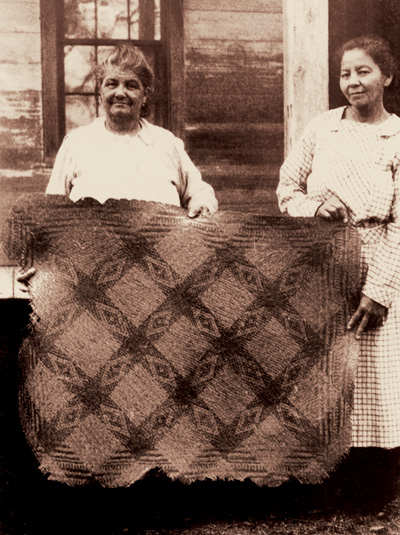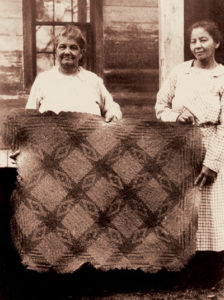Chitimacha Tribe of Louisiana
The Chitimacha Tribe is the only federally recognized tribe in Louisiana to still occupy part of its ancestral territory.

Courtesy of Cammie G. Henry Research Center, Northwestern State University.
Chitimacha weavers Christine and Pauline Paul pose with a rivercane mat made with the Little Trout design.
The Chitimacha Tribe is the only federally recognized tribe to retain and occupy part of its ancestral territory within the present state of Louisiana. It was the first Louisiana tribe to gain federal recognition in 1916, with the remaining tract of Chitimacha land in St. Mary Parish placed in trust by the United States in 1919. The tribe has continued to add to its land base through strategic purchases; however, the present landholdings represent only a fraction of pre-contact Chitimacha territory. According to traditional history, Chitimacha ancestral territory extended across the Louisiana coastal region from the Atchafalaya Basin in the west to the lower Mississippi River drainage and New Orleans area in the east. Four sacred trees once stood sentry over the Chitimacha world demarcating territorial boundaries: one on the Gulf Coast east of the Mississippi River, one at the mouth of the Mississippi River, one at the entrance to Vermilion Bay (Cypremort), and one near Maringouin.
Chitimachas in Colonial Louisiana
Contact between Europeans and Chitimachas may have occurred as early as the sixteenth century, when survivors of Spanish expeditions skirted the Louisiana coastline on their way to Mexico. Today Chitimacha families still tell stories of conquistadors in seafaring vessels who tried unsuccessfully to capture and enslave Chitimachas. After the French established a colony on the Gulf Coast, Chitimachas entered into war against France when French entrepreneurs began to raid Chitimacha villages, taking captives they sold to settlers in Mobile. Renowned basket weaver Pauline Paul (1882–1968) would recall this dark time in stories of Chitimacha ancestors who suffered years of bondage in the French colony. The twelve-year war ended by treaty in 1718 only when Chitimachas agreed to abandon their territory on the lower Mississippi River, just as construction of the new capital of New Orleans began.
Having made peace, Chitimachas joined with other Native nations as participants in the burgeoning colonial economy in New Orleans, exchanging goods like wild game, edible and medicinal plants, deerskins, bear oil, and salt for European merchandise. At about the same time, Chitimacha women began to trade and sell their signature split-rivercane baskets in New Orleans and local markets.
By the time Spain took possession of Louisiana in 1766, Chitimachas were almost fifty years removed from their war with France. Spanish administrators treated Chitimachas as a sovereign nation having the right to self-governance and authority over its remaining lands. Chitimachas began to sell or lease tracts of ancestral land, but Spanish law insured at least one square league of land around each village remained inviolable, preserving some Indigenous property rights.
After the Louisiana Purchase
After colonial Louisiana was transferred back to France and then sold to the United States with the 1803 Louisiana Purchase, many tracts of Chitimacha land were declared public without tribal consultation or consent, making them available to American settlers. The tribe’s remaining tract near present Charenton in St. Mary Parish was confirmed as Chitimacha tribal land by President Franklin Pierce in 1855. Chitimachas continued to occupy their village Kas Kec, and while they sold a few small parcels to local settlers, they were unaware that those sales would result in their communal land becoming subject to taxation.
Chitimacha Basketry
While political standing and land security for Chitimachas deteriorated after 1803, basketry remained a mainstay of the tribal identity and economy. Basketry design motifs reflect the natural world of early weavers, who first captured their impressions in cane. The names of those designs were considered so important that they were among the only vestiges of the Sitimaxa language preserved in the community by the early 1900s. The careful curation of heirloom pattern baskets passed down in weaving families helped create remarkable consistency in basketry designs. By the late nineteenth century, Chitimacha weavers formed a working relationship with women from the tabasco pepper–growing McIlhenny family, extending the market for their baskets throughout the United States. Through that partnership, as well as their association with anthropologists and linguists, Chitimacha baskets were distributed to collectors and museums throughout the world.
Sovereignty and Survival
By the early twentieth century, the Chitimacha Tribe retained only their Kas Kec village at Charenton—a total of 261.54 acres. Subject to acts of violence and racism in the Jim Crow South and suffering extreme poverty and population stress, Chitimachas fought to keep their land and maintain their identity and traditional practices. Through their own tireless efforts and the support of non-Indigenous friends, in 1916 Chitimachas were able to purchase their village land, which was placed in trust by the United States in 1919. Tribal holdings in St. Mary Parish now total 963 acres, with 445 acres in trust. Basketry, a hallmark of Chitimacha identity and culture, played a central role in securing federal recognition and protecting their remaining land.
The Chitimacha Tribe of Louisiana
The Chitimacha Tribe was the first Louisiana tribe to adopt a constitution and is today governed by a five-member tribal council with a tribal chairman. The tribe has a varied business portfolio, including the first land-based casino in Louisiana—Cypress Bayou Casino and Hotel—as well as Raintree Market; Keta (a holding company); Tiya Support Services (a government contractor); and Colorado Professional Resources. Through its diverse businesses, the Chitimacha Tribe is now the second-largest employer in St. Mary Parish. Intratribal services—including the Chitimacha Tribal School and Early Learning Center, police department, fire department, health clinic, housing, and scholarship program—serve the needs of tribal members.
The Chitimacha Tribe prioritizes cultural preservation through its cultural department, tribal historic preservation office, museum, and tribal archives. The tribe continues to support its ancient basketry tradition and was the first Louisiana tribe to regrow stands of rivercane on tribal property, making this vital material available to weavers. With tribal support, weavers have identified and examined approximately one thousand Chitimacha baskets housed in museums nationwide. Once endangered, the Sitimaxa language has undergone revival. Sitimaxa is a part of the curriculum at the Tribal School and Learning Center, and Rosetta Stone’s landmark endangered language project makes software language instruction available to all Chitimacha tribal members. Deeply rooted in the traditional past, the Chitimacha Tribe of Louisiana continues its work to ensure a promising cultural and economic future for Chitimacha people.
